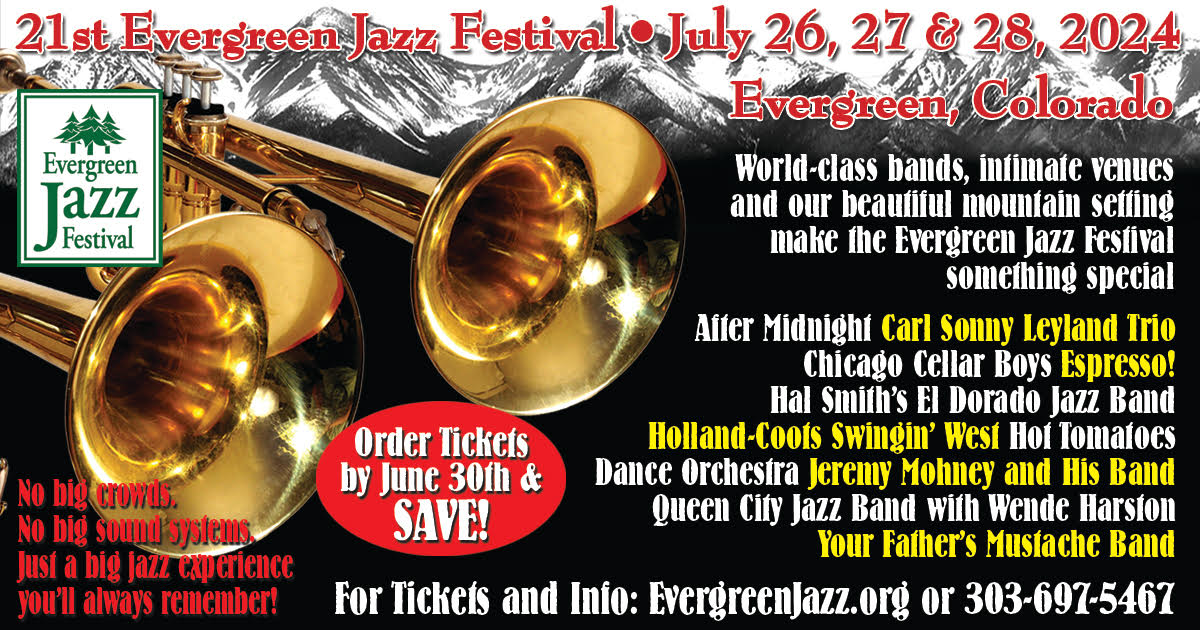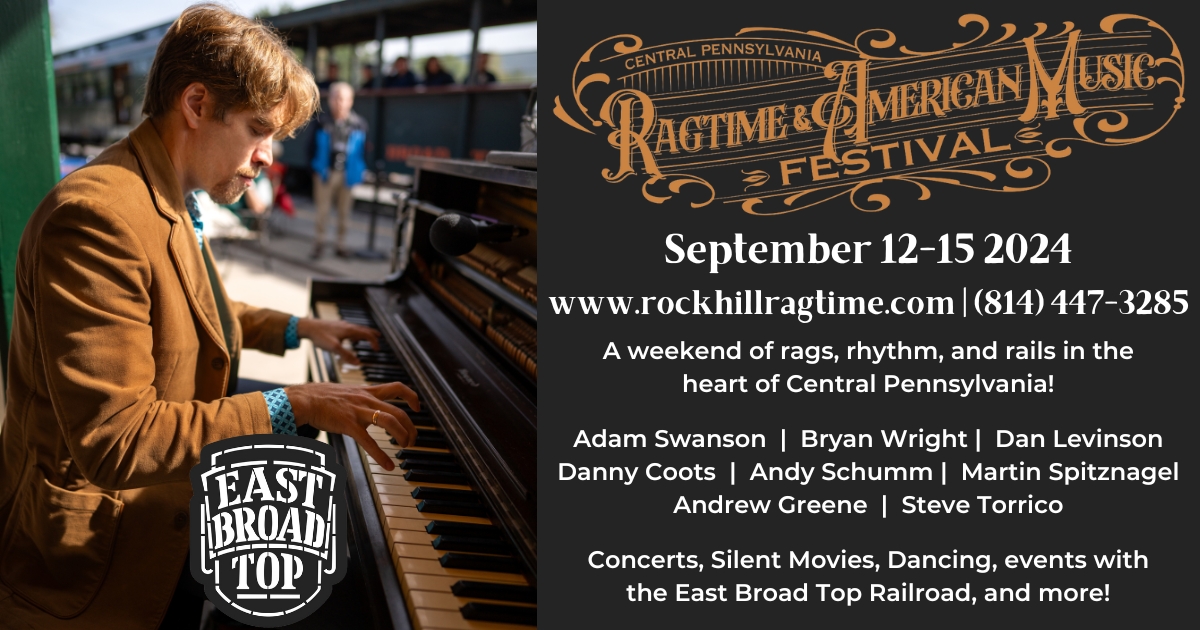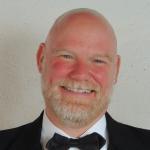Jeff Barnhart: Hal, this month we’re listening to and discussing the music of a really hot, and polished, band from New Orleans. The New Orleans Owls recorded 23 sides between 1925 and 1927 for Columbia (five were rejected and never released); they were the first band to record by the electrical system operating from a mobile recording van. Such technology enabled engineers to capture sounds from locales far and wide, saving the expense of carting bands that were often uninterested in leaving their local gigs to the label’s studio to make a few sides.
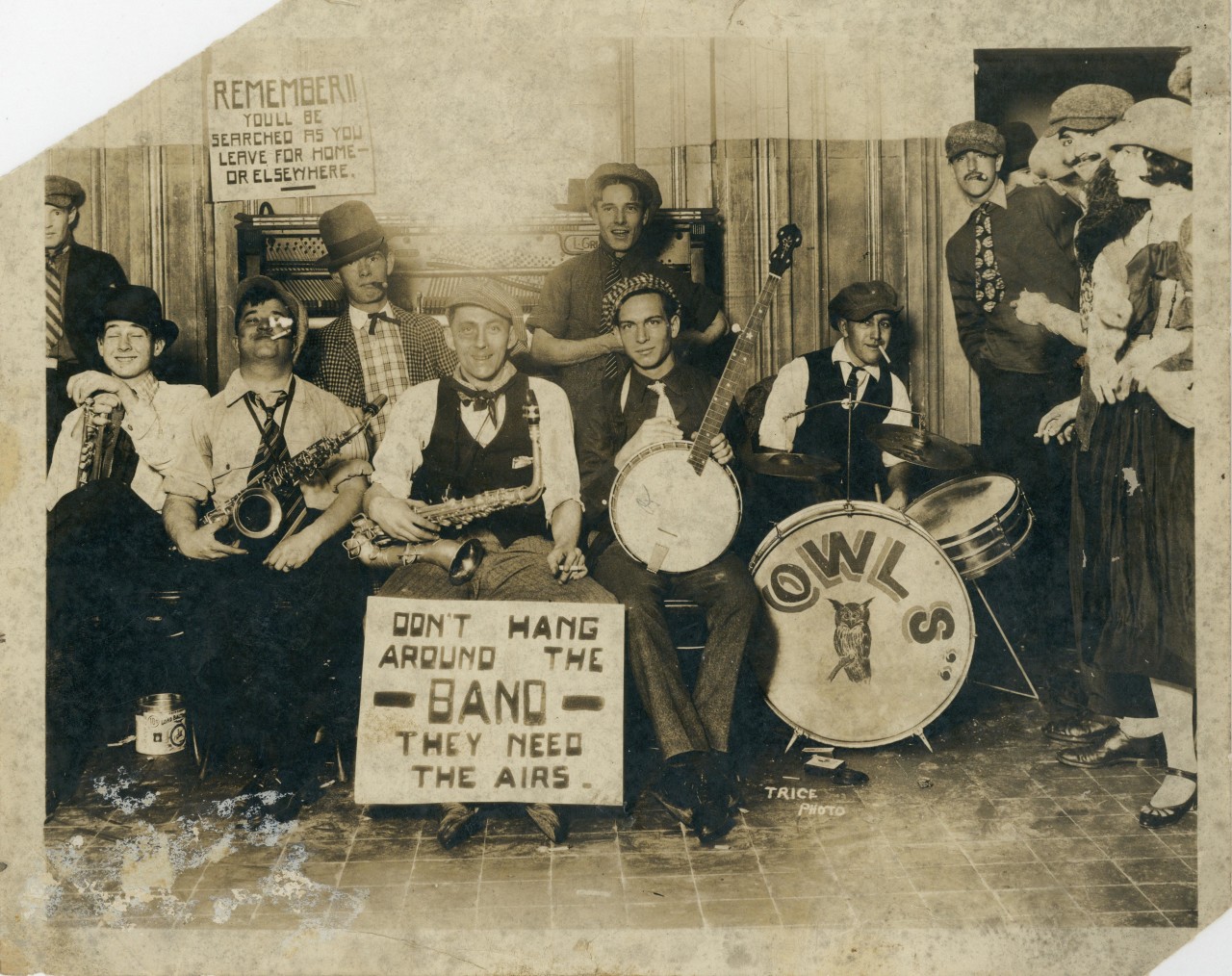
taken at either the Chess, Checkers and Whist Club (formerly the Cosmopolitan Hotel)
or the Sazerac Ballroom. Suggested dates: 1922 or 1924. From left: Dick Mackie,
Monk Smith, Red Mackie, Benjy White, Eblen Rau, Rene’ Gelpi, Earl Crumb. (From the
New Orleans Jazz Museum/Louisiana Digital Library Collection).
The Owls were operating from 1922-29; their primary residency was at the Roosevelt Hotel in New Orleans, although they would replace Abbie Brunies’ Halfway House Orch. (covered in the November, 2022 issue of TST) at the establishment with the same name in the late 1920s. Only a small number of bands recorded in New Orleans during those years, so these sides are precious: so much so that we’ll take two columns to explore the music of the New Orleans Owls, which gives you a chance to flesh out my general outline by describing the elements that make this band one of your all-time favorites!
Hal Smith: Yes, the Owls have been one of my favorite bands for quite awhile. I first became aware of their music in the late 1960s, when I heard their songs “Piccadilly” and “The Owls’ Hoot” on the Merry Makers LP by the “Chicago Ramblers.” That was a great band which included Bert Barr and Tom Jacobus, playing songs associated with Bix, Fletcher Henderson and the New Orleans Owls. Next, I saw that famous photo of the Owls dressed up as tough guys, with the sign reading “Don’t hang around the band. They need THE AIRS.” That is one of the coolest band photos ever! When the band’s recordings became available on LP, I became an instant fan.
Later, I was able to play the Owls’ repertoire with the late Eddie Bayard’s New Orleans Classic Jazz Orchestra. Eddie was a real fan of the Owls and had transcriptions of everything in their repertoire. That was some hot stuff!
Speaking of hot…The band’s first recording session, from Sept. 24, 1925, included “Stomp Off, Let’s Go,” “Oh Me! Oh My!” and “The Owls’ Hoot.” “Stomp Off” is best known as one of Louis Armstrong’s greatest recordings. But the Owls take it in a different direction: closer to the Wolverines than Erskine Tate. But it’s plenty hot! I really like the sound of Bill Padron’s muted cornet, the teamwork of Benjy White and Lester Smith on reeds and the driving rhythm—especially Rene Gelpi on banjo and Earl Crumb on drums (more about him in a while)!
“Oh Me! Oh My!” was composed by “Barr”—no first name. The song sounds like something a New Orleans musician would write. We hear Bill Padron playing both open and muted, an arranged passage for the reeds, a stoptime for muted cornet and a nice outchorus, with Gelpi’s banjo and Crumb’s choke cymbal really making the band go. But—you should hear the first take! Apparently, Columbia was having equipment problems on this session with a resulting rough sound on the masters. Take -2 was the master chosen for release, though a few copies of take –1 also got into circulation. On that one, the last chorus is blazing; surely one of the hottest ever recorded in the Crescent City!
“The Owls’ Hoot” was the last side recorded before Columbia gave up on the session due to the malfunctioning equipment. This is an attractive melody and—again—really sounds like a typical “musician” composition. The cornet is inspired. The reeds blend well and there is a bit of improvisation on their chorus. On the banjo solo, it sounds like two stringed instruments playing together. Since the Owls evolved from the Invincibles String Band, could two sets of strings be a possibility?
Jeff, what appeals to you on this first recording session by the Owls?
JB: So much to discuss, here, Hal. First, my initial exposure to the music of the NOO was Eddie Bayard’s NOCJO, with you on drums (on the CD release, anyway)! I wore the grooves out on the Stomp Off LP featuring that terrific band. I have to admit to never searching out the originals (in the 1990’s there were few options and no one in the early years of this band would become well-known) so this music represents new pathways for me! And I LOVE it! The music is very clear for 1925 due to the electronic equipment used by Columbia’s mobile unit.
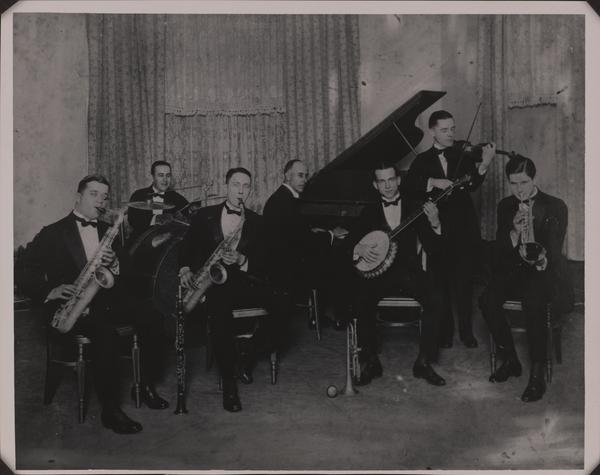
Benjy White, Mose Ferrer, Rene’ Gelpi, Eblen Rau, Dick Mackie. (From the New
Orleans Jazz Museum/Louisiana Digital Library Collection).
“Stomp Off, Let’s Go” is in classic ragtime form, with two choruses of the 16-bar A section in Bb, separated by a 6-bar interlude, into a B-section in Eb with breaks for cornet and sax and the ear worm trio, a 32-bar riff melody in Ab. I love the interplay of the reeds and the churning sounds of the band underneath, and the bouncing tuba of Lan LeBlanc is a joy!
I agree with you that “Oh Me, Oh My” had to be written by a player, not someone sitting around “composing” tunes. This reminds me of the verse-chorus tunes we listened to in Nov. 2022 played by—and often composed by members of—the Halfway House Orch, another white dance band that could play hot while melting your heart with the sweetness of their melodies (the instrumentation on these first sides of the NOO is the same as most of the sides of the HHO: three-horn front line consisting of cornet and two reeds with no trombone).
In New Orleans tradition, the side starts with the ensemble playing the final eight bars of the chorus into the 16-bar verse. It’s great to hear Padron’s open cornet on the verse and then the immediate switch to muted cornet to play the melodic 32-bar chorus, with some righteous note-bending in the final measures. Beyond the description you gave of the roadmap, I’ll share that after the stop-time half-chorus—utilizing a very inventive rhythmic figure—behind Padron, his two-bar break is followed by the entire band coming in to finish the chorus and THEN, the momentum during the final outchorus builds and builds bar by bar to a three-horn wail at the halfway point to the whole band stomping with complete abandonment (reprising that wail to take us out) and you say take -1 was even hotter?? Whoa! I’m frankly not sure I could handle it…
But WAIT, I found it on YouTube and took a listen: it’s taken just a tad faster and you can hear the piano more clearly on it; the reed duet seemed more exciting to me, the rhythm section seamlessly executes the tricky stop-time rhythm behind Padron’s cornet (playing together night after night has its benefits!) and while that final ensemble is white hot, I find take -2 to have a more exciting build and more cohesive ensemble balance. Perhaps the engineers rejiggered things in between takes? No matter, either take shows that there was some VERY exciting music being created in the Big Easy in the 1920s!
Before I cover the final side of their first session, I have to give a shout out to the marvelous, full piano playing of Edward “Mose” Farrer. He doesn’t get any solos, but he is providing hot, proficient accompaniment to the front line every beat of the way!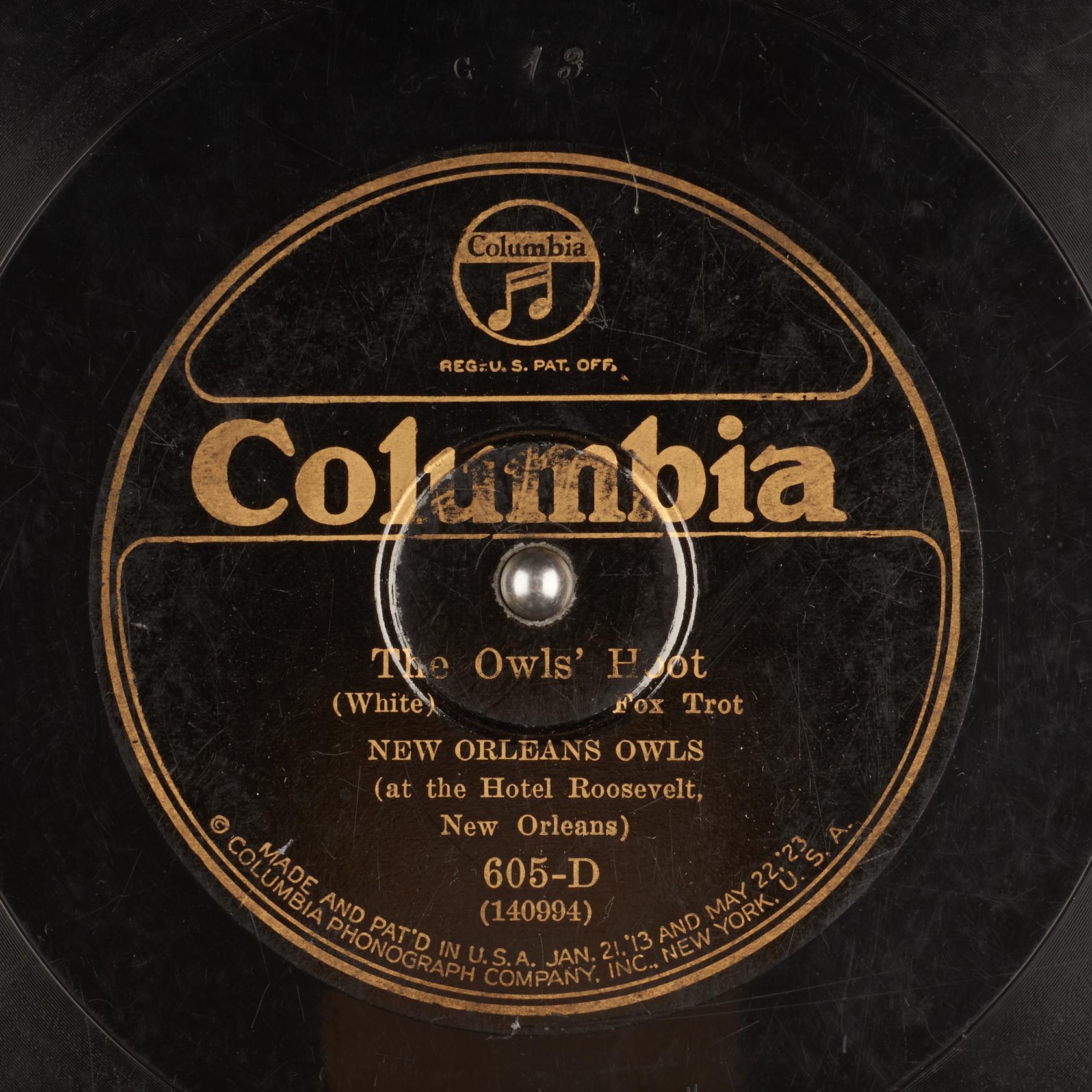
An eight-bar intro leads us into the verse of “The Owl’s Hoot.” Following the formula of “Oh Me, Oh My,” we’re treated to a muted cornet playing the melody of the chorus, with a surprise reed break and tuba walk-up in the middle. Again, the reeds follow with a duet, making the most of harmonizing the lovely chords of the chorus. YES, it sounds like two banjos, with pianist Farrer playing some low register “organ tones” as banjoist Gelpi strums with abandon.
A highlight for me is Farrer’s surprise piano break, a series of chromatically downward 9th chords—a pattern we find in two piano solos recorded four years after this NOO side in the interlude leading to the trio of Frank Melrose’s “Market Street Jive” and more famously throughout Jelly Roll Morton’s “Freakish.” Hal, lead us into the band’s second session!
HS: I really do like that “Market Street Jive”/”Freakish” piano break! Moving on, the band’s second session took place on Apr. 14, 1926 in New Orleans. Frank Netto was added on trombone and Pinky Vidacovich joined the reed section on clarinet and alto sax.
The first selection, “Piccadilly,” (by Elmer Schoebel) was also on that “Chicago Ramblers” LP mentioned previously. It’s a typical Schoebel composition, with multiple strains and plenty of opportunities for hot ensembles, solos and breaks. The Owls sound better than ever, as does the recording quality. There is a strong ensemble, a sock-time alto solo, strong trombone over an ensemble passage, excellent solos by cornet, clarinet (with a propulsive brass bass break) and we hear more of the “Invincibles” heritage in the banjo solo. Bill Padron sounds particularly good on cornet on the last chorus. His break is very much in the Paul Mares tradition. Hearing this, I can just picture the couples high-stepping across the dance floor at the Hotel Roosevelt.
“Tampeekoe” was also composed by Schoebel. Fletcher Henderson also recorded this one, and there could not be more of a contrast between Henderson’s headlong-rush of a tempo and the Owls’ easygoing bounce. We get to hear Frank Netto’s minimalist lead after the modulation to Db, followed by a terrific cornet solo, low-register clarinet, a stoptime for muted cornet and an unhurried outchorus.
“Dynamite” was written by Henderson and Jack Palmer (“I Found A New Baby,” “Everybody Loves My Baby” and others). It features an arranged reed chorus, some charleston rhythms, a single-string banjo solo, followed by a Wolverines-like duet by cornet and clarinet, afterbeats for the cornet, stops for the reeds and a break for muted cornet. Padron stays muted on the last chorus, with clarinet playing over the top of the ensemble.
“Pretty Baby” is not the familiar Tony Jackson song. Rather, this is a sentimental number (I’m thinking it must have been written by one of the band members). There is some beautiful muted cornet on the first chorus, then an impressive modulation to an arranged reed chorus with a trombone break that sounds like Frank Netto was in another room! The clarinet solo has plenty of “sock” with the sax playing straight melody underneath. There is plenty pep and excitement in the outchorus, with Earl Crumb laying down wonderful afterbeats on the choke cymbal.
“West End Romp” was written by Bill Padron and pianist Mose Ferrer. It has a real New Orleans feel right from the start, with a hot ensemble full of breaks, an outstanding muted cornet solo, a split chorus between sax and unmuted cornet and then…we hear clarinet in duet with guitar AND a banjo playing time underneath. Who was the extra string player? With all those musicians who had their origins in the Invincibles, it could have been just about anyone.
“West End” has some impeccably-timed and executed cymbal crashes by Earl Crumb (in fact, ALL the Owls records benefit from his drumming). Remember I mentioned in our previous column that I have a personal connection to the Owls? Well, thanks to Ancestry.com, I was notified of a DNA match to the Crumb family in Louisiana. When I checked their family tree, I found Earl! Since then, I have been in touch with his family and they are very happy to know that Earl’s music is still appreciated and being played. I was able to send them the version of “Oh Me! Oh My!” that I recorded in Chicago with Andy Schumm and the Chicago Cellar Boys and also sent a photo of one of Earl’s cowbells—which was given to me by the late Eddie Bayard. I love having a family connection to this great band!
JB: Hal, that is very exciting, indeed!! You’ve always been one of my favorite drummers and, hearing Earl Crumb’s playing on these sides, it MUST be hereditary!
“Piccadilly” has such a complicated routine it could only be assayed by a band that constantly played together. This is NOT a pick-up band playing “head” arrangements. This stuff requires serious woodshedding. Interesting that the section used for solos and for the final outchorus is, once again, over the changes for “Bucket’s Got a Hole In It,””All the Girls Go Crazy,” “D” section of “Maple Leaf Rag,” the B strain of the Wolverines’ version of “Copenhagen,” or the mystery section of “Panama!” Other than the 12-bar blues, this eight (or 16)-bar section seems among the most prevalent harmonic structures for improvising in early New Orleans Jazz.
The recording quality on this side, and the rest of those from this date, sound so clear they could have been made 97 years later; you can hear every note played by every musician! I love how that opening fanfare is heard throughout the tune in-between choruses and I smiled at the surprise clarinet tag before the band takes it out. Awesome stuff!
The band taking “Tampeekoe” at this relaxed tempo highlights how pretty are these melodies. The arrangement features some beautiful part writing for three-saxes (first strain) and three-clarinets (second strain); wistful then wailing! Interesting that after trombonist Netto’s melody chorus (played with a rich tone), he then doubles the tuba part for a chorus while the reeds play long notes. Unusual choice, but it nicely sets up the cornet solo you mentioned, Hal. Not torrid, not tender: just a loping, swinging ride and simply lovely. After the gentle outchorus, the four bar ensemble tag is a sweet surprise. I’d call this one an almost tender assaying of Schoebel’s tune!
I’m not sure how the previous song was named, but I’ll say the next side, “Dynamite,” lives up to the title! It’s not a fast tempo, but the heat slowly builds as if the fuse is getting closer to the explosives. Having three great reed players in the band adds to some beautiful harmonic passages. The final chorus has plenty of “hot-cha” but one wishes they’d added a second outchorus; with this side coming in at 2:40, they had the time!
Shout-out time again; with five front-line musicians, kudos to the arranger(s) for keeping the ensemble choruses from sounding cluttered. Moreover, musicians who regularly play together meld over time, learning each other’s patterns and working together to keep from clashing. I can only assume portions of the ensembles are arranged with one or two horns allowed leeway to improvise (clarinet on the final chorus of “Dynamite” as an example).
The penultimate tune you’ve brought to the forum this month, “Pretty Baby,” features a brisk tempo and suspenseful ensemble intro that belies the upcoming sweetness in melody and playing. One thing I’ve noticed is that bands in the New Orleans Owls (and Halfway House Orch.) dance tradition heeded Jelly Roll Morton’s admonition to “give ‘em plenty melody.” That strutting clarinet solo you mention is beautifully underpinned by the melody harmonized by two saxes. Never frenetic, this outchorus nevertheless would have elicited some strenuous moves on the dance floor!
Hal, the only part you left out in your thorough description of “West End Romp” that jumped out at me was that terrific two-bar arranged horn interlude traveling seven steps chromatically downwards after the solo cornet melody chorus to bring us from Eb to Ab. GREAT part-writing!
Now, onto your mystery: not knowing exactly who in the band had also played in the preceding outfit, The Invincibles String Band, I’ve only my ears to guide me to the possible identity of the the “phantom” guitar player(s)—I indicate the possibility that there might have been TWO guitarists joining Gelpi’s banjo underneath the clarinet because two bars prior to the four-bar interlude leading to the final ensemble chorus, the guitar “bass” line drops out…why?
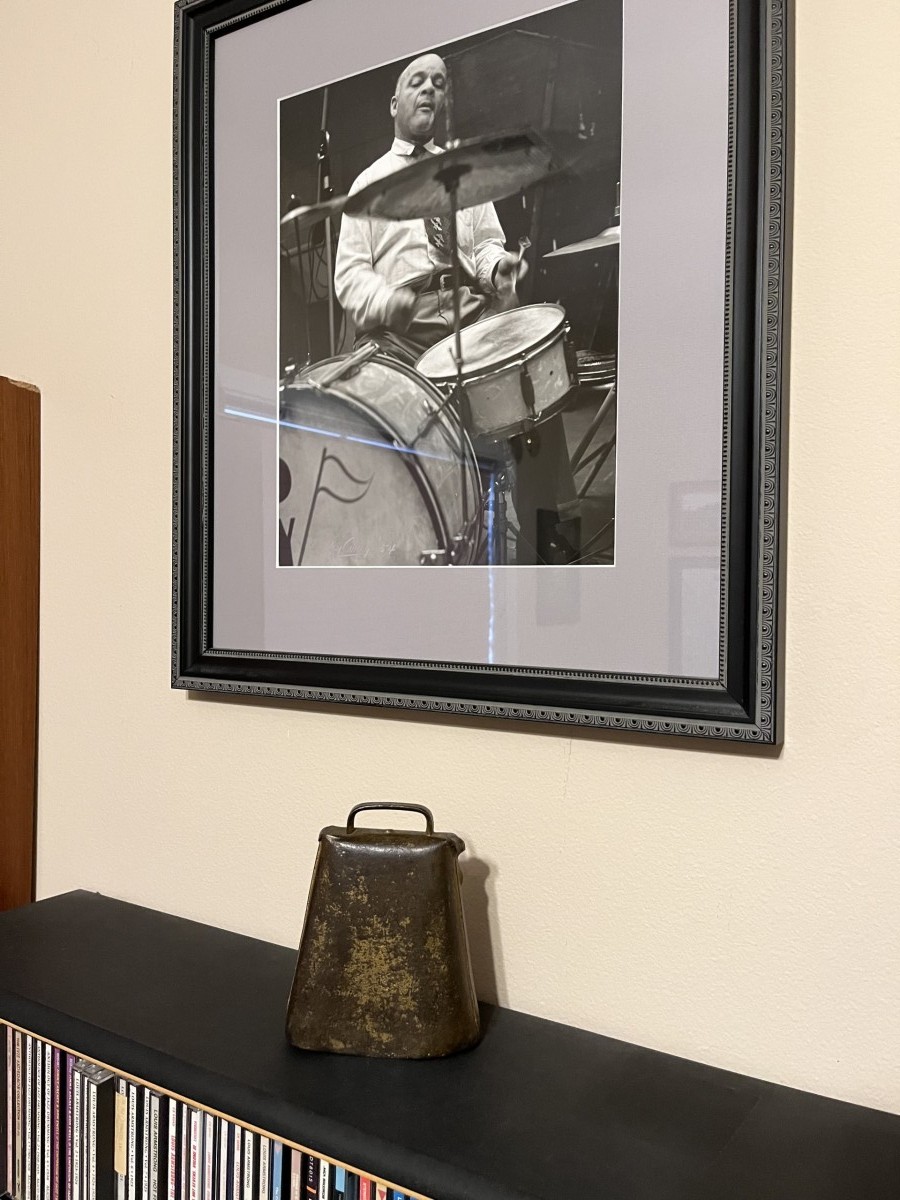
Based on who is still playing leading into that clarinet solo, while remembering that in those early days the ability to “overdub” was still decades away, we can eliminate cornet, piano, and (obviously!) banjo. That leaves tubist LeBlanc (who drops out two bars early), either of the remaining reed players, trombonist Netto or drummer Crumb; I don’t hear drums after the cymbal splashes between the sax and cornet rides on the split chorus.
Further clues can be found in the following four-bar interlude: in the first two bars LeBlanc comes in right away, and I can hear both Padron and Netto so we can eliminate them; it’s unlikely Crumb would be able to get a guitar out of the way in time to choke the cymbal during the second bar, so he’s out; my vote is for either or both of the reed players not playing the clarinet solo, as they don’t come in until bar three of the final interlude leading to the outchorus.
My apologies, Hal, this sort of microscopic analysis might leave you (and most of our readers) glassy-eyed, but it appeals to my obsessive-compulsive nature! Any final thoughts on this (or any) subject before we bid adieu to the New Orleans Owls until next month?
HS: Thanks for mentioning the interlude on “West End Romp.” There is such an embarrassment of riches contained in the recordings of the New Orleans Owls that it’s nearly impossible to list all of them in one article!
Regarding the second (or possibly) third stringed instrumentalist: Could one of the “Invincibles” have stopped by to listen and wound up sitting in (uncredited)? Since we receive messages from several jazz historians and researchers, we may well be able to solve this mystery by the time we finish writing the second installment of this article.
JB: People reaching out to us is one of the aspects of this collaboration that I most value, Hal. Next month, we’ll listen to more Owls then you can shake a barn at!






